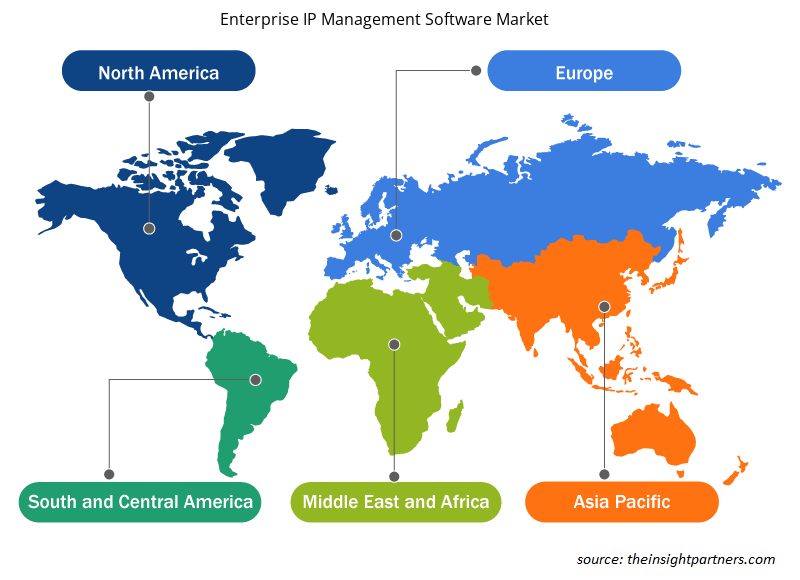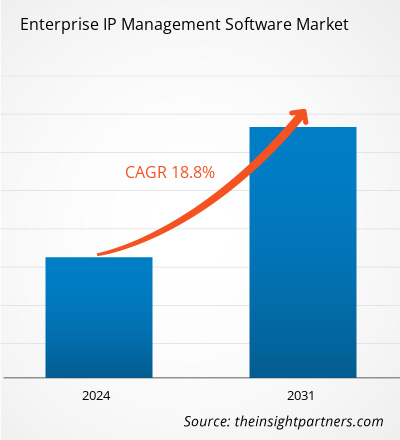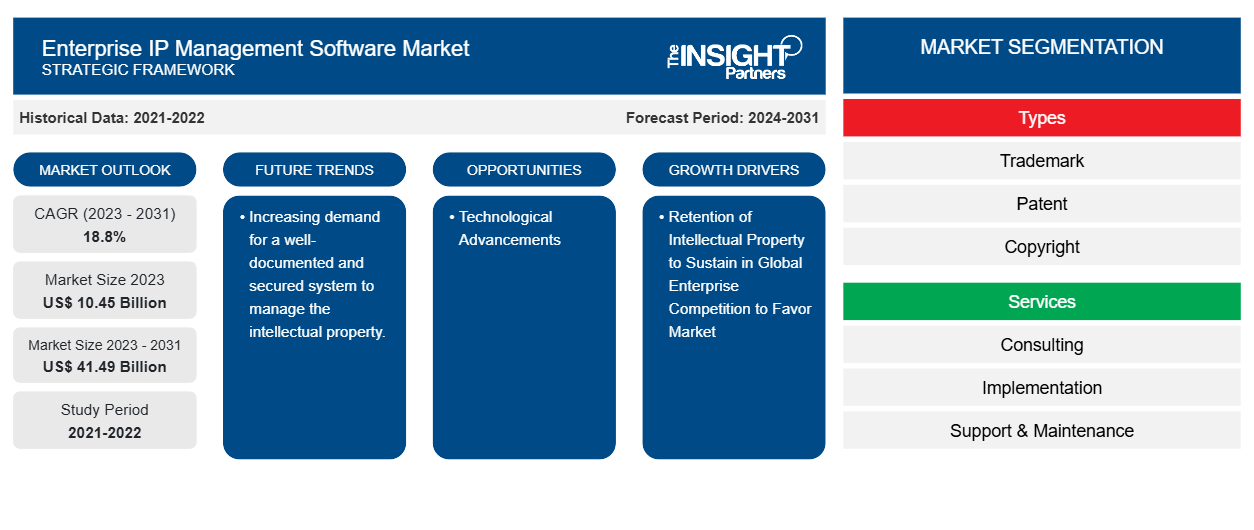Se proyecta que el tamaño del mercado de software de gestión de propiedad intelectual empresarial alcance los 41.490 millones de dólares en 2031, frente a los 10.450 millones de dólares en 2023. Se espera que el mercado registre una CAGR del 18,8 % entre 2023 y 2031.CAGR of 18.8% in 2023—2031. Es probable que la retención de la propiedad intelectual para mantenerse en la competencia empresarial global y el creciente número de nuevos canales de distribución sigan siendo tendencias clave en el mercado de software de gestión de propiedad intelectual empresarial.
Análisis del mercado de software de gestión de propiedad intelectual empresarial
El mercado de software de gestión de propiedad intelectual empresarial ha crecido y se ha adoptado a un ritmo considerable en los últimos años, y se prevé que estas tendencias continúen en los próximos años. Los países en desarrollo en la era de la globalización dependen de la propiedad intelectual (PI) para su progreso económico. Las economías en desarrollo de la región APAC están empezando a reconocer el valor de la propiedad intelectual (PI), su necesidad y cómo afecta al comercio y la inversión. A pesar de los muchos beneficios que ofrecen las relaciones internacionales (RI), la mayoría de las naciones de la región APAC carecen de los procedimientos necesarios para emitir y hacer cumplir los derechos de propiedad intelectual, lo que además causa grandes pérdidas a las empresas.APAC's developing economies are beginning to recognize the value of intellectual property (IP), its necessity, and how it affects commerce and investment. Despite the many benefits that international relations (IR) offers, most APAC nations lack the necessary procedures to issue and enforce intellectual property rights, which further causes large losses for businesses.
Descripción general del mercado de software de gestión de propiedad intelectual empresarial
Las empresas que poseen marcas y patentes o esperan obtenerlas utilizan el software para la gestión de la propiedad intelectual. El software para la gestión de la propiedad intelectual también ayuda a los abogados y a los bufetes de abogados especializados en propiedad intelectual en la planificación, ejecución y resultado de las presentaciones y litigios de propiedad intelectual.
Personalice este informe según sus necesidades
Obtendrá personalización en cualquier informe, sin cargo, incluidas partes de este informe o análisis a nivel de país, paquete de datos de Excel, así como también grandes ofertas y descuentos para empresas emergentes y universidades.
-
Obtenga las principales tendencias clave del mercado de este informe.Esta muestra GRATUITA incluirá análisis de datos, desde tendencias del mercado hasta estimaciones y pronósticos.
Factores impulsores y oportunidades del mercado del software de gestión de propiedad intelectual empresarial
Retención de la propiedad intelectual para sustentar la competencia empresarial global en favor del mercado
Los activos de propiedad intelectual son herramientas importantes y adaptables para fomentar y mantener la rivalidad empresarial. Lo más importante que han hecho la globalización y la liberalización del comercio es que todas las empresas, incluidas las PYME, sean competitivas a escala mundial, incluso si operan en el mercado local de un país. Las PYME necesitan un plan de negocios claro para seguir siendo competitivas. Deben aumentar constantemente la productividad, reducir los costos de producción y mejorar la reputación de su línea de productos a través de diversos medios, como invertir en I+D, adquirir nueva tecnología, crear mejores diseños y comercializar con éxito sus productos.SMEs, competitive on a global scale, even if they are operating in one country's local market. SMEs need a clear business plan in order to stay competitive. They must constantly increase productivity, lower production costs, and improve the reputation of their product line through a variety of means, such as investing in R&D, acquiring new technology, creating better designs, and successfully marketing their goods.
Avances tecnológicos
Los avances tecnológicos pueden revolucionar los mercados establecidos de software de gestión de propiedad intelectual empresarial, abrir nuevas vías de negocio y modificar el comportamiento de los clientes. Las empresas deben mantenerse al día con los avances tecnológicos si quieren seguir siendo competitivas.
Informe de mercado de software de gestión de propiedad intelectual empresarial Análisis de segmentación
Los segmentos clave que contribuyeron a la derivación del análisis del mercado de software de gestión de propiedad intelectual empresarial son los tipos, los servicios y el usuario final.
- Según el tipo, el mercado de software de gestión de propiedad intelectual empresarial se divide en marcas comerciales, patentes, derechos de autor, diseño y litigios. Se prevé que el segmento de marcas comerciales crezca en el período de pronóstico.
- Por servicios, el mercado se segmenta en consultoría, implementación y soporte y mantenimiento. Se prevé que el segmento de consultoría crezca en el período de pronóstico.
- Según el usuario final, el mercado de software de gestión de propiedad intelectual empresarial se divide en BFSI, farmacéutica, automotriz, aeroespacial y de defensa, tecnología de la información e institutos de investigación. Se prevé que el segmento BFSI crezca en el período de pronóstico.BFSI, pharmaceutical, automotive, aerospace & defense, information technology and research institutes. The BFSI segment is anticipated to grow in the forecast period.
Análisis de la cuota de mercado del software de gestión de propiedad intelectual empresarial por geografía
El alcance geográfico del informe de mercado de software de gestión de propiedad intelectual empresarial se divide principalmente en cinco regiones: América del Norte, Asia Pacífico, Europa, Oriente Medio y África, y América del Sur/América del Sur y Central. América del Norte ha dominado el mercado de software de gestión de propiedad intelectual empresarial. Las tendencias de adopción de alta tecnología en varias industrias en la región de América del Norte han impulsado el crecimiento del mercado de software de gestión de propiedad intelectual empresarial. Se espera que factores como la mayor adopción de herramientas digitales y el alto gasto tecnológico por parte de las agencias gubernamentales impulsen el crecimiento del mercado de software de gestión de propiedad intelectual empresarial en América del Norte. Además, un fuerte énfasis en la investigación y el desarrollo en las economías desarrolladas de los EE. UU. y Canadá está obligando a los actores norteamericanos a traer soluciones tecnológicamente avanzadas al mercado. Además, Estados Unidos tiene muchos actores del mercado de software de gestión de propiedad intelectual empresarial que se han centrado cada vez más en el desarrollo de soluciones innovadoras. Todos estos factores contribuyen al crecimiento de la región del mercado de software de gestión de propiedad intelectual empresarial.
Perspectivas regionales del mercado de software de gestión de propiedad intelectual empresarial
Los analistas de Insight Partners explicaron en detalle las tendencias y los factores regionales que influyen en el mercado de software de gestión de propiedad intelectual empresarial durante el período de pronóstico. Esta sección también analiza los segmentos y la geografía del mercado de software de gestión de propiedad intelectual empresarial en América del Norte, Europa, Asia Pacífico, Oriente Medio y África, y América del Sur y Central.

- Obtenga datos regionales específicos para el mercado de software de gestión de propiedad intelectual empresarial
Alcance del informe de mercado de software de gestión de propiedad intelectual empresarial
| Atributo del informe | Detalles |
|---|---|
| Tamaño del mercado en 2023 | US$ 10,45 mil millones |
| Tamaño del mercado en 2031 | US$ 41,49 mil millones |
| CAGR global (2023 - 2031) | 18,8% |
| Datos históricos | 2021-2022 |
| Período de pronóstico | 2024-2031 |
| Segmentos cubiertos |
Por tipos
|
| Regiones y países cubiertos |
América del norte
|
| Líderes del mercado y perfiles de empresas clave |
|
Densidad de actores del mercado de software de gestión de propiedad intelectual empresarial: comprensión de su impacto en la dinámica empresarial
El mercado de software de gestión de propiedad intelectual empresarial está creciendo rápidamente, impulsado por la creciente demanda de los usuarios finales debido a factores como la evolución de las preferencias de los consumidores, los avances tecnológicos y una mayor conciencia de los beneficios del producto. A medida que aumenta la demanda, las empresas amplían sus ofertas, innovan para satisfacer las necesidades de los consumidores y aprovechan las tendencias emergentes, lo que impulsa aún más el crecimiento del mercado.
La densidad de actores del mercado se refiere a la distribución de las empresas o firmas que operan dentro de un mercado o industria en particular. Indica cuántos competidores (actores del mercado) están presentes en un espacio de mercado determinado en relación con su tamaño o valor total de mercado.
Las principales empresas que operan en el mercado de software de gestión de propiedad intelectual empresarial son:
- Compañía Anaqua, Inc.
- Aclarar
- WebTMS
- Propiedad Intelectual Cardenal, Inc.
- Patrix AB
- Tarc flexible
Descargo de responsabilidad : Las empresas enumeradas anteriormente no están clasificadas en ningún orden particular.

- Obtenga una descripción general de los principales actores clave del mercado de software de gestión de propiedad intelectual empresarial
Noticias y desarrollos recientes del mercado de software de gestión de propiedad intelectual empresarial
El mercado de software de gestión de propiedad intelectual empresarial se evalúa mediante la recopilación de datos cualitativos y cuantitativos a partir de una investigación primaria y secundaria, que incluye publicaciones corporativas importantes, datos de asociaciones y bases de datos. A continuación, se incluye una lista de los avances del mercado:
- En febrero de 2023, Resurgens Technology Partners, una empresa de capital privado centrada en software, anunció que su empresa de cartera, Wellspring, el proveedor líder de software de innovación y gestión de propiedad intelectual, ha completado la adquisición de IP Pragmatics, una empresa líder en consultoría y servicios para la transferencia de tecnología y la gestión de la propiedad intelectual.
(Fuente: Resurgens Technology Partners, comunicado de prensa, 2023)
- En abril de 2022, Anaqua, el proveedor líder de tecnología de gestión de propiedad intelectual e innovación, anunció sus planes de lanzar su nueva solución de divulgación de información automatizada como parte de su oferta de gestión de propiedad intelectual AQX para corporaciones y bufetes de abogados. El nuevo sistema ayudará a los profesionales de la propiedad intelectual a ahorrar tiempo y dinero al agilizar y automatizar el proceso de divulgación de información.
(Fuente: Anaqua, Nota de Prensa, 2022)
Informe sobre el mercado de software de gestión de propiedad intelectual empresarial: cobertura y resultados
El informe "Tamaño y pronóstico del mercado de software de gestión de propiedad intelectual empresarial (2021-2031)" proporciona un análisis detallado del mercado que cubre las siguientes áreas:
- Tamaño del mercado y pronóstico a nivel global, regional y nacional para todos los segmentos clave del mercado cubiertos bajo el alcance
- Dinámica del mercado, como impulsores, restricciones y oportunidades clave
- Principales tendencias futuras
- Análisis detallado de las cinco fuerzas de Porter y PEST y FODA
- Análisis del mercado global y regional que cubre las tendencias clave del mercado, los principales actores, las regulaciones y los desarrollos recientes del mercado.
- Análisis del panorama de la industria y de la competencia que abarca la concentración del mercado, el análisis de mapas de calor, los actores destacados y los desarrollos recientes
- Perfiles detallados de empresas
- Análisis histórico (2 años), año base, pronóstico (7 años) con CAGR
- Análisis PEST y FODA
- Tamaño del mercado, valor/volumen: global, regional y nacional
- Industria y panorama competitivo
- Conjunto de datos de Excel
Informes recientes
Informes relacionados
Testimonios
Razón para comprar
- Toma de decisiones informada
- Comprensión de la dinámica del mercado
- Análisis competitivo
- Información sobre clientes
- Pronósticos del mercado
- Mitigación de riesgos
- Planificación estratégica
- Justificación de la inversión
- Identificación de mercados emergentes
- Mejora de las estrategias de marketing
- Impulso de la eficiencia operativa
- Alineación con las tendencias regulatorias























 Obtenga una muestra gratuita para - Mercado de software de gestión de propiedad intelectual empresarial
Obtenga una muestra gratuita para - Mercado de software de gestión de propiedad intelectual empresarial